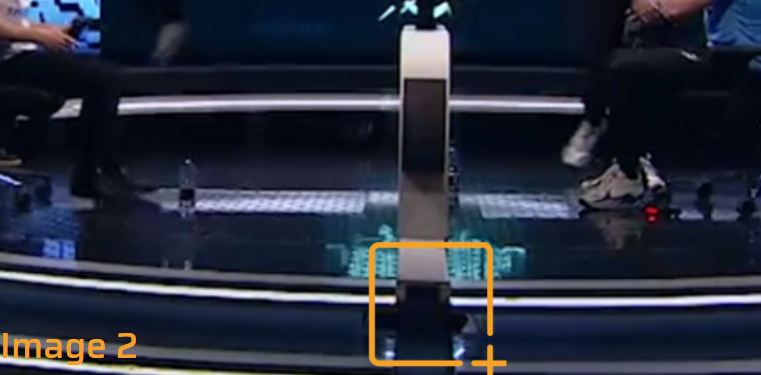AI Object Detection in Streams
By Maria Karampatzaki, Tue Jun 15 2021
Contents
- How to increase media value for sponsors in stream
- How does AI Detection work?
- Why is an AI Model underperforming?
- Tips for Improving Media value for Sponsors in Streams
How to increase media value for sponsors in stream
As part of the agreement with one of our clients, we are tracking the placement of the Xbox and Xbox Series S Consoles in their broadcasts and streams. In preparation for training the model, we have collected data about the current placement and integration of the Xboxes in streams and broadcasts.
The Problem
Due to the Xbox’s positioning in the broadcasts, we anticipate negligible media value created. By looking at how AI detection works and considering this in relation to the setup, we were able to identify key points that will increase the media value created for the Xbox when applied. These findings can be more generalized and applied to any logo or object placed in a stream, and with that are a valuable aid when trying to maximise results for sponsors.
How does AI Detection work?
AI detection is a complex process and employs something called a neural network. The neural network gets trained to perform a specific task through the much talked about big data and machine learning.
Summarized and simplified, the process works like this: A neural network is trained to find objects and logos in images or text supplied to it. This is done by feeding it many examples of the logo or objects it is supposed to recognize.
Through the training, a “model” is created that can detect objects and logos in the data fed to it. This also means that every time a new logo or object is supposed to be recognized, the model needs to be retrained until the model performs up to scratch again.
Even though the Xbox logo has been previously tracked, and humans know that the logo represents the console, the AI does not until it has been trained to do so.
Theoretically, a perfectly trained AI model is much better at detecting logos than humans are. It analyzes the video on a pixel by pixel, frame by frame level. Therefore, it is capable of noticing exposures that are only there for a blink of an eye and would be overlooked by humans.
We at Cavea aim for a detection rate of 80% to 90%, as this is closer to what a human detection rate realistically would be.
Why is an AI Model underperforming?
The most common reason for an AI model underperforming is a lack of data available to train the model. Therefore making it difficult for the model to recognize not “perfect” representations of the logo.
To explain it in more human terms: A baby has always seen their father with a beard. It has never seen the father without a beard before. Therefore it only has gathered data points of dad with the beard. If the father decides to shave his beard, the child might not recognize him straight away. It has first to learn that, yes, that is still the same person, that looks a bit different. In the future, the child will recognize the father either way, blank-faced or bearded.
The same goes for the AI; if the logo is different from the representations it has been fed with, either being the short version of a logo, in a different colour, or only partially visible, the Ai will struggle to detect it. Continuing to train the model with more diverse data will lead to a vastly improved detection rate.
The second most common reason for the lack of detections is the video or setup conditions. To a large degree, this lack of detections mirrors the potential lack of detections by humans.
The are several conditions that lead to a lower detection. One of them is Streams of hectic and colourful games like Fortnite. It is harder for the AI to detect logos or objects in the Stream because a lot is going on in every single frame. The same goes for extremely busy stream overlays. Other issues include logos on the sleeves of jerseys facing away from the camera, scrunched-up material, and logos that are only partially visible. Similarly, logos on Jersey or other objects filmed in rooms with bad lighting or low resolution will decrease the chance of detection as well.
Because the AI analyzes the Images differently than humans do, Type II errors or false positives are more likely than for humans. In contrast, humans tend to have more Type I errors. We, therefore, display the timestamp and location of every single detection, so we can conduct regular quality assurance to make sure that the model is performing to standard and the media value is correct
If the AI has trouble detecting logos or objects due to video conditions or the setup, chances are very high viewers will not see the object or logo either.

There are similar issues with the recognition of the Xbox X on Image 2. The console is placed centrally but could be just any other part of the setup or furniture, as it is black in a very dimly lit part of the stage.
Even with a large amount of data and the most accurate AI model possible, detection of the console will be abysmal in the current setup. This will lead to a lower media value created, even though the Xbox is present in the broadcast. However, this would accurately reflect the actual value created as viewers are not likely to notice it. Would you be able to notice the console?

Several options would very likely increase the detection rate of the Xbox for humans and AIs alike:
- Making sure nothing is standing on the console.
- Placing a controller next to the Xbox. The controllers of the Xbox have a very distinct and recognizable shape. The detection of the AI would then be trained for the controller instead of the console itself, but it would significantly increase recognition from the model and people alike.
- Making sure the console is turned on so that the Xbox logo is “glowing” and turned towards the camera. The logo is a relatively bright spot on the console and will be easier to track.
- Positioning the Xbox so that the top, which features part with the green optical glowing illusion, is facing the camera and ensures that the effect is visible through correct lighting.
Tips for Improving Media value for Sponsors in Streams
While the Xbox detection is a particular case, some general tips can be applied to increase the media value of brands during a Stream.
Anything that increases the visibility of the logo will most likely increase media value, which includes but is not limited to:
- Ensuring proper lighting during the stream if logos are displayed on jerseys or if objects are being tracked.
- Make sure that the logos in-stream overlays on Jerseys and objects have enough contrast to busy backgrounds.
- If peripheral sponsorships like headphones, chairs or similar, are being tracked through object detection, a combination of having the object in focus and choosing a very distinct looking variant of the object can improve detection and visibility.